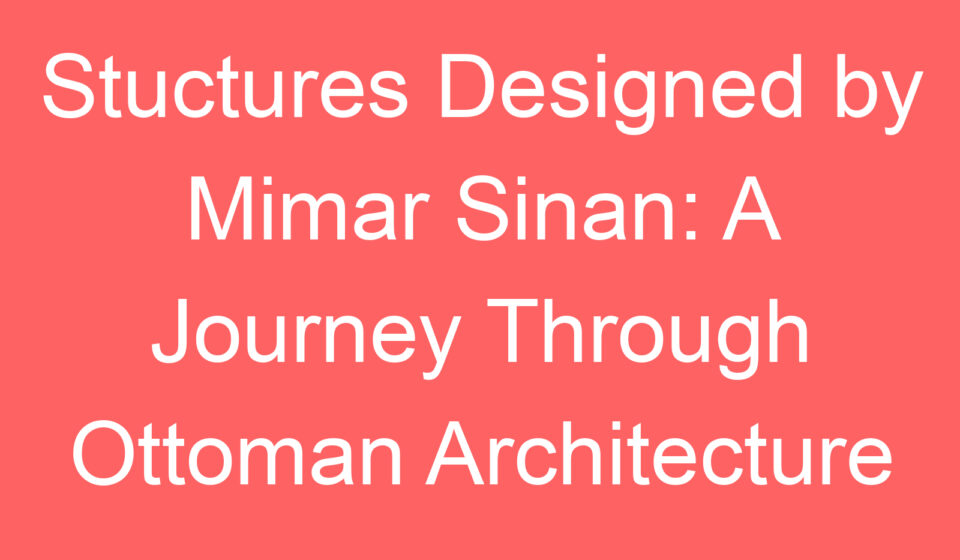
Stuctures Designed by Mimar Sinan: A Journey Through Ottoman Architecture
When visiting Turkey, one name you will hear again and again in the world of art, design, and architecture is Mimar Sinan—the chief imperial architect of the Ottoman Empire. Often regarded as the Michelangelo of the East, Sinan served under three sultans (Süleyman the Magnificent, Selim II, and Murad III) and left behind a legacy of over 300 structures that reshaped the skyline of Istanbul and many cities across the empire. His works, ranging from monumental mosques to functional bridges, continue to inspire awe and admiration centuries later. To walk through Istanbul or Edirne today is, in many ways, to walk through Sinan’s architectural vision of the Ottoman world.
Table Of Content
- The Life and Vision of Mimar Sinan
- Must-See Mosques of Mimar Sinan
- 1. Süleymaniye Mosque (Istanbul, 1550–1557) 🕌
- 2. Selimiye Mosque (Edirne, 1568–1574) 🕌
- 3. Şehzade Mosque (Istanbul, 1543–1548) 🕌
- 4. Rüstem Pasha Mosque (Istanbul, 1561–1563) 🕌
- 5. Sokollu Mehmet Pasha Mosque (Istanbul, 1571–1572) 🕌
- 6. Şemsi Pasha Mosque (Üsküdar, 1580–1581) 🕌
- Beyond Mosques: Sinan’s Other Works
- What Makes Sinan’s Work Unique?
- Planning Your Visit
- Tips for Tourists
- Final Thoughts
- Related Posts
The Life and Vision of Mimar Sinan
Born around 1490 in Anatolia, Sinan began his career as a military engineer in the Ottoman army. He traveled across the empire, gaining experience in construction and engineering while serving on campaigns in Persia, the Balkans, and the Middle East. This background gave him firsthand knowledge of architectural traditions ranging from Byzantine domes to Persian courtyards, which he later wove into his unique style. Rising through the ranks, he was appointed Chief Imperial Architect in 1538, a position he held for nearly half a century. His role was not only to design but also to supervise hundreds of construction projects, from the grandest mosques to vital infrastructure. His genius lay in combining practicality with artistry, building structures that were both durable and breathtaking.
Must-See Mosques of Mimar Sinan
1. Süleymaniye Mosque (Istanbul, 1550–1557) 🕌
Perhaps Sinan’s most famous work in Istanbul, the Süleymaniye Mosque dominates the city’s skyline. Commissioned by Sultan Süleyman the Magnificent, this mosque is more than just a place of worship—it is a full complex (külliye) featuring a hospital, schools, baths, a caravanserai, and a library. The vast central dome, nearly 53 meters high, is supported by semi-domes and buttresses that distribute weight seamlessly. Visitors can admire the marble courtyard, intricate calligraphy, and the breathtaking view over the Golden Horn. It remains a masterpiece of harmony and proportion.
2. Selimiye Mosque (Edirne, 1568–1574) 🕌
Considered Sinan’s greatest achievement, the Selimiye Mosque in Edirne is recognized by UNESCO as a World Heritage Site. The mosque’s colossal dome, wider than Hagia Sophia’s, rests on eight slender pillars, creating an interior space that feels both immense and airy. The delicate minarets, rising nearly 71 meters, emphasize verticality and grace. Sinan himself described this work as the culmination of his career, calling it his “masterpiece.” Travelers often highlight the sense of serenity inside the mosque, where light pours through stained-glass windows onto exquisite tilework.
3. Şehzade Mosque (Istanbul, 1543–1548) 🕌
Built in memory of Sultan Süleyman’s son, Prince Mehmed, this mosque is often referred to as Sinan’s “apprentice work.” Despite being early in his career, the mosque already showcases his architectural signature: symmetry, balanced domes, and elegant courtyards. Its calm gardens make it an ideal spot for visitors looking for a quieter mosque away from the more crowded tourist attractions.
4. Rüstem Pasha Mosque (Istanbul, 1561–1563) 🕌
Nestled above a row of shops near the Spice Bazaar, the Rüstem Pasha Mosque is celebrated for its dazzling İznik tilework. Almost every surface of the interior glows with colorful floral and geometric patterns in shades of cobalt blue, turquoise, and red. Though smaller in size than Sinan’s imperial mosques, its artistry makes it one of Istanbul’s hidden gems.
5. Sokollu Mehmet Pasha Mosque (Istanbul, 1571–1572) 🕌
Located in the Kadırga district, this mosque is a fine example of Sinan’s ability to adapt designs to difficult terrain. Built on a sloping hillside, its plan cleverly incorporates the landscape while maintaining symmetry. The interior is adorned with rare İznik tiles, including panels featuring verses from the Qur’an. The balance of space and decoration gives it an understated elegance that continues to impress visitors.
6. Şemsi Pasha Mosque (Üsküdar, 1580–1581) 🕌
On the Asian side of Istanbul, right by the Bosphorus, stands the Şemsi Pasha Mosque. This small yet enchanting structure is often regarded as one of the most charming mosques in the city. With its intimate courtyard, waterfront setting, and harmonious proportions, it shows Sinan’s mastery in designing spaces that blend seamlessly with nature.
Beyond Mosques: Sinan’s Other Works
Sinan’s genius extended far beyond religious structures. His contributions to Ottoman infrastructure, civic life, and imperial grandeur included bridges, aqueducts, schools, hospitals, baths, and mausoleums. A few notable examples:
- 🌉 Mustafa Pasha Bridge (Svilengrad, Bulgaria, 1529): One of Sinan’s earliest works, this stone bridge stretches over the Maritsa River with a series of elegant arches, demonstrating his engineering prowess.
- 🏛️ Haseki Sultan Complex (Istanbul, 1538): Commissioned by Hürrem Sultan, wife of Süleyman the Magnificent, this complex provided vital services to the community, including education, healthcare, and food for the poor.
- 💧 Aqueducts and Water Systems: Sinan designed and restored aqueducts that carried fresh water to Istanbul, ensuring the city’s growth and sustainability. The Mağlova Aqueduct, still standing today, is one of the most impressive examples of his hydraulic engineering.
- 🛁 Public Baths (Hamams): Sinan constructed several baths that combined functionality with aesthetic refinement, such as the Haseki Hürrem Sultan Hamam near Hagia Sophia, which remains in use today.
What Makes Sinan’s Work Unique?
- 🧱 Structural Innovation: Sinan perfected the art of dome construction. His skill in balancing thrust and counter-thrust allowed him to create vast interiors without obstructive supports, leaving worshippers under seemingly weightless domes.
- 🌿 Integration with Environment: From mosques that crown Istanbul’s hills to riverside gems like Şemsi Pasha, Sinan designed buildings that enhanced their surroundings rather than dominating them.
- 🎨 Artistry and Functionality: His works were both practical and beautiful—serving as schools, hospitals, soup kitchens, and bridges, while also standing as testaments to Ottoman power and faith.
- 🌍 Global Recognition: Over 30 of his works are listed as UNESCO World Heritage Sites, making him one of the most celebrated architects in history.
Planning Your Visit
If you’re exploring Istanbul, you can design your own Mimar Sinan Trail to appreciate his genius up close:
- 🗺️ Begin at the Süleymaniye Mosque, exploring its külliye with its library, madrasas, and tombs of both Sinan and Süleyman the Magnificent.
- 🏙️ Stroll down towards the Rüstem Pasha Mosque, tucked near the Spice Bazaar. Take time to appreciate the İznik tiles and compare them to those at the Sokollu Mehmet Pasha Mosque.
- ⛴️ Take a ferry to Üsküdar to enjoy the tranquil setting of Şemsi Pasha Mosque, especially beautiful at sunset.
- 🌳 If time allows, visit the Şehzade Mosque for its calm gardens and symmetrical beauty.
For those venturing beyond Istanbul, a day trip to Edirne’s Selimiye Mosque is highly recommended. The journey itself offers a glimpse into Ottoman history, and standing beneath Selimiye’s vast dome is an experience many travelers describe as unforgettable.
Tips for Tourists
- 📸 Best Time to Visit: Mornings and late afternoons are ideal for photography, as the sunlight enhances the domes and courtyards.
- 🙏 Respect Local Customs: When visiting mosques, dress modestly and remove your shoes before entering. Women are advised to cover their heads with a scarf.
- 🧭 Guided Tours: Hiring a guide can provide deeper insights into Sinan’s life and design principles, adding context to what you see.
- 🛍️ Combine with Nearby Attractions: Many of Sinan’s mosques are located near Istanbul’s famous bazaars, palaces, and neighborhoods, making it easy to create a full-day itinerary.
Final Thoughts
Mimar Sinan’s works are not just buildings; they are living legacies of an empire that valued faith, beauty, and public service. His ability to blend engineering with artistry created structures that remain functional and inspirational centuries later. For tourists, exploring Sinan’s architecture is more than sightseeing—it is a journey into the very heart of Ottoman civilization.
Whether you stand under the monumental dome of the Süleymaniye Mosque, admire the intricate tiles of Rüstem Pasha, or watch the Bosphorus waves lap against Şemsi Pasha, you are experiencing the vision of a man who shaped the identity of a city and an empire. Mimar Sinan’s architectural wonders are enduring testaments to human creativity, and they promise to leave an unforgettable mark on your journey through Turkey.

